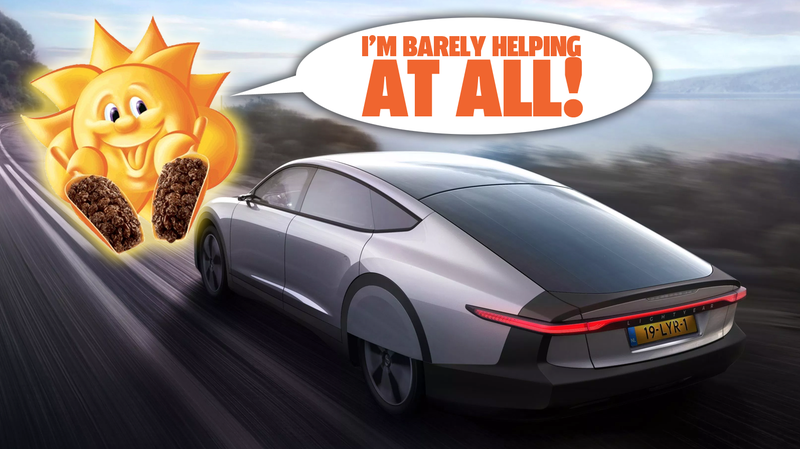
The tagline of Lightyear One’s website reads “Lightyear One | The electric car that charges itself with sunlight,” and while, yes, this is technically true, in practice it’s really sort of bullshit. Yes, the car does have about 15 square feet of fairly efficient solar panels, but calling it a “solar” car like manyoutlets are doing, is very misleading.
It’s an impressively designed EV, overall, with four hub motors, one per wheel, it’ll apparently go from 0 to 62 mph in an OK 10 seconds, has advanced torque vectoring, and a claimed range of 450 miles. Lightyear claims that the solar panels used on the hood, roof, and rear window area of the car provide 20 percent more energy than conventional solar cells.

And, yes, if this is all accurate, the Lightyear One’s solar charging capability is much better than other cars that have claimed to be powered by the sun, like the Karma Revero, which had a solar roof that was, charitably, a joke.
Advertisement
While the Lightyear One appears to have much more solar panel coverage, let’s look into what it would actually take to run the car on solar power, like its website suggest.
Really, the company’s definitely suggesting that the car essentially relies on the solar charging. Look at this:

Advertisement
That’s from its site, in the section talking about solar charging. It’s suggesting that their solar panels will give you “independence from charging stations,” so you’re “free to roam the world.” Also:

Advertisement
Using “up to” in this context is always deceiving. Sure, you can get “up to 100 percent” of your mileage via solar energy if you only drive five miles a month. The phrase is meaningless. Hell, I can get “up to 100 percent” of my yearly mileage covered on one gallon of gas in my Pao if I only drive, oh, 40 miles per year.
Using Lightyear’s own numbers for how much charge its solar panels provide, 12 kilometers (7.5 miles) per hour of the car charging in the sun, let’s see what trying to only use this as a solar car would mean.
Advertisement
If we go with that 20,000 kilometer/12,427.42 miles per year number the company gave, which comes to 1,666 hours of charge at the stated rate of 12 kilometers/7.5 miles of range per hour of solar charging, which means that you’re looking at 138 days of charging, assuming, with wild, insane optimism, that you have 12 hours of good, direct sunlight every day.

Advertisement
Let’s try thinking of it more in terms of charging it up to the battery’s capacity: 450 miles of range (untested by any official agencies yet, but we’ll take their word for now). To get to 450 miles of range at 7.5 miles of range per hour of sunlight, you’d need at least 60 hours of sunlight, which is five days of an optimistic 12 hours of full sunlight, which is pretty much impossible.
I think a week of the car parked in direct sunlight seems very, very roughly fair, though I think even that is pretty optimistic. Maybe it’d be plausible because the panels are always available, even while you’re driving, if you’re lucky enough to be driving in perfect, sunny weather.
Advertisement
Again, I’m not saying it’s not able to get power from the sun, I’m just saying it’s incredibly unrealistic to rely on it and pretty deceptive to tout it as a big selling feature.

Advertisement
Lightyear One also mentions that the solar panels can be used as an “Emergency range extension,” letting you creep along at 9 to 12 mph just on the energy you get from direct sunlight. I don’t know about you, but running out of range and creeping along in the slow lane of the highway at somewhere around a healthy person’s jogging speed, slower than most bicycles, doesn’t seem all that great, especially if you happen to do anything crazy like drive into a shadow or drive at night.
It’s better than being completely immobile, I guess?
It is possible to build a true solar-powered car, but our current state of technology means that some pretty severe weight and size and design restrictions have to be obeyed. The team that built the Lightyear One, from the Eindhoven University of Technology in the Netherlands, did build what is likely the most practical true solar car ever, called Stella.
Advertisement

While huge and spacious for a solar powered car, Stella was incredibly light—under 900 pounds—for a real, practical, everyday car. Lightyear One looks to be an impressively engineered and well-designed car, and there is some real benefit to its solar cells—but it is a huge, huge stretch to market it as a “solar powered” car.
Advertisement
Most experts agree it makes more sense to charge a battery-powered EV from stationary solar cells on a house or building, and operate a sun-powered car that way. Dragging the cells with you everywhere has some cool tech appeal, but current technology means they’re just not going to do you much good, will be useless at least half of every day, and can get dirty or damaged.
Lightyear One marketers, lay off on the solar-powered angle. It just makes you seem shady.













